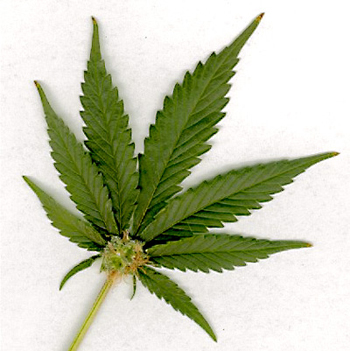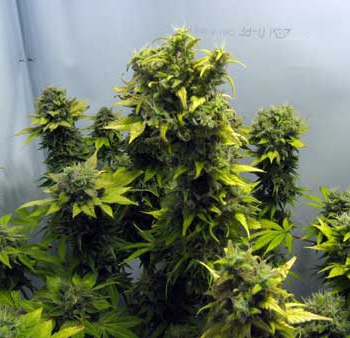Contents:
Common Names | Parts Usually Used | Plant(s) & Culture | Where Found | Medicinal Properties | Biochemical Information
Legends, Myths and Stories | Uses | Formulas or Dosages | How Sold | Warning | Resource Links | Bibliography
Scientific Names

- Cannabis sativa L.
- Cannabinaceae
- Hemp family
Common Names
- Bhang
- Bud
- Grass
- Hemp
- Huo Ma Ren
- Indian Hemp
- Marijuana
- Marihuana
- Pot
- Weed
Parts Usually Used
Flowering tops, leaves, seeds
Back to Top

Description of Plant(s) and Culture
Cannabis is an herbaceous annual plant; the rough, angular, branched stems reach a height of 3-10 feet and bear opposite, or alternate toward the top, palmate leaves with 5-7 narrow, lanceolate, coarsely serrate, pointed leaflets. The flowers are small and green, the male growing on one plant in axillary panicles, the female on another plant in spike-like clusters from August to October. The fruit is a small, ash-colored achene.
Back to Top
Where Found
Found growing wild and is cultivated in warm climates. Grows to some extent everywhere in the United States, especially in the central and midwestern states.
Back to Top

Medicinal Properties
Analgesic-hypnotic, topical anesthetic, antiasthmatic, antibiotic, antiepileptic, antispasmodic, antidepressant, tranquilizer, antitussive, appetite stimulant, oxytoxic, preventative and anodyne for neuralgia (including migraines), aid to phychotherapy, and agent to ease withdrawal from alcohol and opiates
Back to Top
Biochemical Information
19% protein, 31% lipids, choline, trigonelline, zylose, inositol, phytin, enzymes (lipase, maltase, emulsin, linamarase, amylase, urease, nuclease, erepsin, tryptase, calalase)
Back to Top
Legends, Myths and Stories
The hemp plant was used by Chinese for the fiber as early as 2800 BC. By 500 AD the plant had spread to Europe, then brought to the New World by explorers. Today it is a common plant found wild or cultivated over most of the world.
The mind-affecting properties have been known since antiquity. The Greek historian Heroditus (5th century BC), reported the ancient Scythians and Tracians got high on the fumes of the roasted seeds. Because of the effects on the mind, hemp drugs are outlawed or restricted in most countries of the world; but the demand for them is more than sufficient to maintain considerable illegal world traffic. (Eliminate the market and the supplier will stop the illegal traffic.)
Hemp drugs are prepared in 3 main grades: bhang, ganja, and charras. Bhang, the least potent and cheapest form, consists basically of the dried leaves and flowering tops of male and female hemp plants. The marijuana used in the United States is comparable to bhang in quality and potency. Ganja, a more potent preparation, consists of a mixture of resin and plant parts from the flowering tops of female plants. Charras, the most potent and expensive grade, consists of pure resin from the female flowers of plants grown at high altitudes. Within the 3 main grades are further graduations of quality, depending on the actual method of preparation. Hashish, for example, is an inferior grade of charris.
The word “assassin” is generally linked with hashish through the Arabic word “hashshashin” or “hashishin” (meaning “hashish eaters”), a term applied to a class of followers of a Persian secret society active from the 11th to 13th century AD. Assassination of enemies, the predominant feature of the sect, was carried out by the hashishin under the influence of a drug, presumably hashish. Both the identification of hashish with the drug involved and the validity of the etymology of assassin have been challenged as inaccurate. A definitive resolution to this question is of some importance, since the story of the Persian assassins provides one of the main arguments for those who associate marijuana with crime.
Back to Top
Uses
Used to control migraines. Seeds are a stimulating laxative. Restrictions placed on cannabis in the United States since 1937 have practically eliminated its use as a medicinal agent, and even research into its properties was practically nonexistent until the last few years. Its medical history suggests that cannabis has only low toxicity (no confirmed deaths have been attributed directly to cannabis poisoning), but it also indicates that cannabis drugs are unstable and of variable potency. The euphorigenic substances of cannabis, isomers of tetrahydrocannabinol (THC), are found particularly in resins contained in the upper leaves and the bracts of the female flowers.
The seeds do not have any of the intoxicating properties of the leaves and flowers. They are even used as a healthful peasant food in China. Seeds are used for constipation for older people, febrile diseases, post-partum women, and anemia.
Cannabis sativa is the source of a tough fiber used to produce ropes.
The leaves and flower buds show promise of useful drugs of the future, as sources of an anti-nauseant for chemotherapy patients, as an antibiotic for gram-positive bacteria, and as a treatment for glaucoma. A research company in Massachusetts states that marijuana may well find application in the treatment of certain forms of psychiatric illness such as depression.
In the following podcast, Pharmacist Shawna Kraft discusses medical marijuana for cancer patients. She gives an understanding what it is, how to use it and how best to request it.
Formulas or Dosages
Infusion: 1 oz. of the pounded seed meal is simmered in 1 qt. of water until the liquid reduces down to 1 pint. Take this in 3 doses throughout the day.
Back to Top
How Sold
Currently illegal in most U.S. states, but in some states where it has been made legal for medicinal purposes, the loose, dried herb can be purchased in medical marijuana stores. So far, the person needing the medical marijuana needs a prescription to purchase it. More and more states are looking into the potential legalization of medicinal marijuana.
Back to Top
Warning
Not recommended for use without medical supervision. Plants grown in dry, sandy soil are the most active medicinally.
It is illegal to grow this plant without a permit.
Back to Top
Resource Links
CBD Oil: Considerations if You Plan to Try it for Chronic Pain
Back to Top
Bibliography
![]() The Complete Medicinal Herbal
The Complete Medicinal Herbal, by Penelope Ody, Dorling Kindersley, Inc, 232 Madison Avenue, New York, NY 10016, First American Edition, copyright 1993
![]() Culpeper’s Complete Herbal & English Physician: Updated With 117 Modern Herbs
Culpeper’s Complete Herbal & English Physician: Updated With 117 Modern Herbs, by Nicholas Culpeper, Meyerbooks, publisher, PO Box 427, Glenwood, Illinois 60425, 1990, (reprint of 1814)
![]() Eastern/Central Medicinal Plants
Eastern/Central Medicinal Plants, by Steven Foster and James A. Duke., Houghton Mifflin Company, 215 Park Avenue South, New York, NY 10000
![]() The Herb Book
The Herb Book, by John Lust, Bantam Books, 666 Fifth Avenue, New York, NY. copyright 1974.
![]() Indian Herbalogy of North America
Indian Herbalogy of North America, by Alma R. Hutchens, Shambala Publications, Inc., Horticultural Hall, 300 Massachusetts Avenue, Boston, Massachusetts 02115, 1973
Herbal Gardening, compiled by The Robison York State Herb Garden, Cornell Plantations, Matthaei Botanical Gardens of the University of Michigan, University of California Botanical Garden, Berkeley., Pantheon Books, Knopf Publishing Group, New York, 1994, first edition
 Earl Mindell’s Herb Bible
Earl Mindell’s Herb Bible, by Earl Mindell, R.Ph., Ph.D., Simon & Schuster/Fireside, Rockefeller Center 1230 Avenue of the Americas, New York, New York 10020
![]() Planetary Herbology
Planetary Herbology, by Michael Tierra, C.A., N.D., O.M.D., Lotus Press, PO Box 325, Twin Lakes. WI 53181., Copyright 1988, published 1992
![]() The Yoga of Herbs: An Ayurvedic Guide to Herbal Medicine
The Yoga of Herbs: An Ayurvedic Guide to Herbal Medicine, by Dr. David Frawley & Dr. Vasant Lad, Lotus Press, Twin Lakes, Wisconsin, Second edition, 1988.
![]() Webster’s New World Dictionary
Webster’s New World Dictionary, Third College Edition, Victoria Neufeldt, Editor in Chief, New World Dictionaries: A Division of Simon & Schuster, Inc., 15 Columbus Circle, New York, NY 10023
 The Rodale Herb Book: How to Use, Grow, and Buy Nature’s Miracle Plants (An Organic gardening and farming book)
The Rodale Herb Book: How to Use, Grow, and Buy Nature’s Miracle Plants (An Organic gardening and farming book), edited by William H. Hylton, Rodale Press, Inc. Emmaus, PA, 18049., 1974
